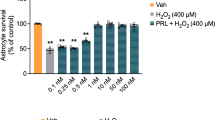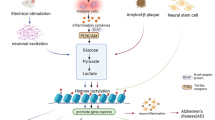Abstract
The protective effects of fructose-1,6-biphosphate (FBP) during hypoxia/ischemia are thought to result from uptake and utilization of FBP as a substrate for glycolysis or from stimulation of glucose metabolism. To test these hypotheses, we measumed CO2 and lactate production from [6-14C]glucose, [1-14C]glucose, and [U-14C]FBP in normoxic and hypoxic cultured astrocytes with and without FBP present. FBP had little effect on CO2 production by glycolysis, but increased CO2 production by the pentose phosphate pathway. Labeled FBP produced very small amounts of CO2. Lactate production from [1-, and 6-14C]glucose increased similarly during hypoxic hypoxia; the increase was independent of added FBP. Labeled lactate from [U-14C]FBP was minimal. We conclude that exogenous FBP is not used by astrocytes as a substrate for glycolysis and that FBP alters glucose metabolism.
Similar content being viewed by others
References
Farias, L. A., Smith, E. E., and Markov, A. K. 1990. Prevention of ischemic-hypoxic brain injury and death in rabbits with fructose-1,6-diphosphate. Stroke 21:606–613.
Farias, L. A., Sun, J., and Markov, A. K. 1989. Improved brain metabolism with fructose 1–6 diphosphate during insulin-induced hypoglycemic coma. Am. J. Med. Sci 297:294–299.
Farias, L. A., Willis, M., and Gregory, G. A. 1986. Effects of fructose-1,6-diphosphate, glucose, and saline on cardiac resuscitation. Anesthesiology 65:595–601.
Kuluz, J. W., Gregory, G. A., Han, Y., Deitrich, D., and Schlein, C. L. 1993. Fructose-1,6-bisphosphate reduces infarct volume after reversible middle cerebral artery occlusion in rats. Stroke 24: 1576–1583.
Trimarchi, G. R., De Luca, R., Campo, G. M., Scuri, R., and Caputi, A. P. 1990. Protective effects of fructose-1,6-bisphosphate on survival and brain putrescine levels during ischemia and recirculation in the mongolian gerbil. Stroke (Suppl iv):iv-171–iv-173;.
Gregory, G. A., Yu, A. C. H., and Chan, P. H. 1989. Fructose-1,6-bisphosphate protects astrocytes from hypoxic damage. J. Cereb. Blood Flow & Metab. 9:29–34.
Gregory, G. A., Welsh, F. A., Yu, A. C. H., and Chan, P. H. 1991. Fructose-1,6-bisphosphate reduces ATP loss from hypoxic astrocytes. Brain Res. 516:310–312.
Hassinen, I. E., Nuutinen, E. M., Ito, K., Nioka, S., Lazzarino, G., Giardina, B., and Chance, B. 1991. Mechanism of the effect of exogenous fructose 1,6-bisphosphate on myocardial energy metabolism. Circulation 83:584–593.
Heckler, F. R., Markov, A. K., White, T. Z., and Jones, E. W. 1983. Effect of fructose-1,6-diphosphate (FDP) on canine hind limbs subjected to tourniquet ischemia. J. Hand Surg. (Am.) 8: 622–623.
Markov, A. K. 1986. Hemodynamics and metabolic effects of fructose 1–6 diphosphate in ischemia and shock—experimental and clinical observations. Annals Emer. Med. 15:1470–1477.
Lowry, O. H., Passonneau, J. V. 1964. The relationship between substrates and enzymes of glycolysis in brain. J. Biol. Chem. 239: 31–42.
Norberg, K., and Siesjo, B. K. 1975. Cerebral metabolism in hypoxic hypoxia I. Pattern of activation of glycolysis: A reevaluation. Brain Res. 8:31–44.
Lowry, O. H., and Passonneau, J. V. 1966. Kinetic evidence for multiple binding sites on phosphofructokinase. J. Biol. Chem. 241: 2268–2279.
Mansour, T. E. 1963. Studies on heart phosphofructokinase: purification, inhibition, and activation. J. Biol. Chem. 238:2286–2292.
Rigobello, M. P., Bianchi, M., Deana, R., and Galzigna, L. 1982. Interaction of fructose-1,6-diphosphate with some cell membranes. Agressologie 23:63–66.
Galzigna, L., Rizzoli, V., Bianchi, M., Rigobello, M. P., and Scuri, R. 1989. Some effects of fructose-1,6-diphosphate on rat myocardial tissue related to a membrane-stabilizing action. Cell Biochem. Function. 7:91–96.
Booher, H., and Sensenbrenner, M. 1972. Growth and cultivation of dissociated neurons and glial cells from embryonic chick, and rat brain in flask cultures. Neurobiology 2:97–105.
Yu, A. C. H., Chan, P. H., and Fishman, R. A. 1986. Effects of arachidonic acid on glutamate and γ-aminobutyric acid uptake in primary cultures of rat cerebral astrocytes and neurons. J. Neurochem. 47:1181–1189.
Hertz, L., Juurlink, B. H. J., and Szuchet, S. 1985. Cell cultures. Pages 603–666, in Laitha, A. (ed.), Handbook of Neurochemistry, Vol. 8, 2nd Edition, Plenum Press, New York.
Lowry, O. H., Rosebrough, N. J., Farr, A. L., and Randall, R. J. 1951. Protein measurements with the Folin phenol reagent. J. Biol. Chem. 193:265–275.
Itoh, T., and Quastel, J. H. 1975. Acetoacetate metabolism in infant and adult brain in vivo. Biochem. J. 116:641–655.
Edmond, J., Robbins, R. A., Bergstrom, J. D., Cole, R. A., and deVellis, J. 1987. Capacity for substrate utilization in oxidative metabolism by neurons, astrocytes, and oligodendrocytes from developing brain in primary culture. J. Neurosci. Res. 18:551–561.
Horowicz, P., and Larrabee, M. G. 1962. Metabolic partitioning of carbon from glucose by mammalian sympathetic ganglion. J. Neurochem. 9:407–420.
Kaufman, E. E., and Driscoll, B. F. 1992. Carbon dioxide fixation in neuronal and astroglial cells in culture. J. Neurochem. 58:258–262.
Shank, R. P., Bennett, G. S., Freytag, S. O., and Campbell, G. L. 1985. Pyruvate carboxylase: An astrocyte-specific enzyme implieated in the replenishment of amino acid neurotransmitter pools. Brain Res. 329:364–367.
Yu, A. C. H., Drejer, J., Hertz, L., and Schousboe, A. 1983. Pyruvate carboxylase activity in primary cultures of astrocytes and neurons. J. Neurochem. 41:1484–1487.
Markov, A. K., Fletcher, J. A., Lehan, P. H., Hellems, H. K., and Street, D. 1986. Reduction of mortality and myocardial ischemia reperfusion injury with fructose-1,6-diphosphate (FDP). J. Am. College. Cardiol. 7:167A.
Candiani, A., Costrini, R., Cifra, E., De Santis, A. M., Lenzi, A., and Gasparetto, A. 1984. Fructose diphosphate and mean erythrocyte survival after extracorporeal circulation. Agressologie 25: 1019–1022.
Galzigna, L., and Rigobello, M. P. 1986. Proton and potassium fluxes in rat red blood cells incubated with sugar phosphates. Experientia 42:138–139.
Lazzarino, G., Cattani, L., Costrini, R., Mulieri, L., Candiani, A., and Galzigna, L. 1984. Increase in intraerythrocyte fructose-1,6-diphosphate. Clin Biochem. 17:42–45.
Loreck, D. J., Galarraga, J., Van der Feen, J., Phang, J. M., Smith, B. H., and Cummins, C. J. 1987. Regulation of the pentose phosphate pathway in human astrocytes and gliomas. Met. Brain Dis. 2:31–46.
Jones, J. W., Gionis, T. A., Nichols, R. L., Markov, A., and Webb, W. R. 1980. Myocardial preservation using diphosphofructose: Energy without oxygen. Surg. Forum. 31:307–308.
Markov, A. K., Oglethorpe, N., Grillis, M., Neely, W. A., and Hellems, H. K. 1983. Therapeutic action of fructose-1,6-diphosphate in traumatic shock. World J Surg. 7:430–436.
Markov, A. K., Terry, J., White, T., Young, D. B., Lehan, P. H., and Hellems, H. K. 1981. Protective action of fructose-1,6-diphosphate in hemorrhagic shock. Circulation II 64:231–236.
Markov, A. K., Turner, M. D., Oglethorpe, N., Neeley, W. A., and Hellems, H. K. 1981. Fructose-1,6-diphosphate: An agent for treatment of experimental endotoxin shock. Surgery 90:482–488.
Hood, K., and Holloway, R. 1976. The significant role of fructose-1,6-diphosphate in regulatory kinetics of phosphofructokinase. FEBS Letter 68:8–14.
Speranza, M. L., Valentini, G., and Malcovati, M. 1990. Fructose-1,6-bisphosphate-activated pyruvate kinase from Escherichia coli. Nature of bonds involved in the allosteric mechanism. Eur. J. Biochem. 191:701–704.
Kauppinen, R. A., Enkvist, K., Holopainen, I., and Akerman, K. E. O. 1988. Glucose deprivation depolarizes plasma membrane of cultured astrocytes and collapses transmembrane potassium and glutamate gradients. Neurosci. 26:283–289.
Selak, I., Skaper, S. D., and Varon, S. 1985. Pyruvate participation in the low molecular weight trophic activity for central nervous system neurons in glia-conditioned media. J. Neurosci. 5:23–28.
Larrabee, M. G. 1980. Metabolic disposition of glucose carbon by sensory ganglia in 15-day old chicken embryos, with new dynamic models of carbohydrate metabolism. J. Neurochem. 35:210–231.
Larrabee, M. G. 1982. [14C]Glucose metabolism in sympathetic ganglia of chicken embryos and in primary cultures of neurons and of other cells from these ganglia. J. Neurochem. 38:215–232.
Hothersall, J. S., Baquer, N. Z., Greenbaum, A. L., and McLean, P. 1979. Alternative pathways of glucose utilization in brain. Changes in the pattern of glucose utilization in brain during development and the effect of phenazine methosulfate on the integration of metabolic routes. Arch. Biochem. Biophys. 198: 478–492.
Zubairu, S., Hothersall, J. S., El-Hassan, A., McLean, P., and Greenbaum, A. L. 1983. Alternative pathways of glucose utilization in brain: changes in the pattern of glucose utilization and of the response of the pentose phosphate pathway to 5-hydroxytryptamine during aging. J. Neurochem. 41:76–83.
Kirtley, M. E., and McKay, M. 1977. Fructose-1,6-diphosphate, a regulator of metabolism. Mol. Cell Biochem. 18:141–149.
Lazzarino, G., Viola, A. R., Mulieri, L., Rotilio, G., and Mavelli, I. 1987. Prevention by fructose-1,6-bisphosphate of cardiac oxidative damage induced in mice by subchronic doxorubicin treatment. Cancer Res. 47:6511–6516.
Markov, A. K., Finch, C. D., and Hellems, H. K. 1987. Prevention of superoxide generation and inhibition of oxygen burst in human and canine neutrophils with fructose 1–6 diphosphate (FDP). Pages 691–696,in Tsuchiya, M., Asano, M., Mishima, Y., and Oda, M. (eds.), Microcirculation, Elsevier Science Publishing Co., New York/Amsterdam.
Tavazzi, B., Cerroni, L., Di Pierro, D., Lazzarino, G., Nuutinen, M., Starnes, J. W., and Giardina, B. 1990. Oxygen radical injury and loss of high-energy compounds in anoxic and reperfused rat heart: prevention by exogenous fructose-1,6-bisphosphate. Free Rad. Res. Comms. 10:167–176.
Bristow, J., Bier, D. W., and Lange, L. G. 1987. Regulation of adult and fetal myocardial phosphofructokinase. Relief of cooperativity and competition between fructose 2,6-bisphosphate, ATP, and citrate. J. Biol. Chem. 262:2171–2175.
Kayne, F. J. 1973. Pyruvate kinase. The Enzymes 8:353–382.
Seubert, W., Schoner, W. 1971. The regulation of pyruvate kinase. Current Topics in Cellular Regulation 3:237–267.
Hill, D. E., and Hammes, G. G. 1975. An equilibrium binding study of the interaction of fructose-6-phosphate and fructose-1,6-bisphosphate with rabbit muscle phosphofructokinase. Biochem. 14:203–213.
Bridges, R. B., Palumbo, M. P., and Wittenberger, C. L. 1975. Purification and properties of an NADP-specific 6-phosphogluconate dehydrogenase from streptococcus fecalis. J. Biol. Chem. 250:6093–6100.
Dyson, J. E. D., and D'Orazio, R. E. 1971. 6-Phosphogluconate from sheep liver: Inhibition of the catalytic activity by fructose-1,6-diphosphate. Biochem. Biophysic. Res. Comm. 43:183–188.
Dominguez, J. E., Graham, J. F., Cummins, C. J., Loreck, D. J., Galarraga, J., Van der Feen, J., DeLaPaz, R., and Smith, B. H. 1986. Enzymes of glucose metabolism in cultured human gliomas: neoplasia is accompanied by altered hexokinase, phosphofructokinase, and glucose-6-phosphate dehydrogenase levels. Metabolic. Brain Disease 2:17–30.
McCarey, E. 1982. The biochemistry of fetal brain development and myelination. Page 278, in Jones, C. T. (ed.), The Biochemical Development of the Fetus and Neonate, Elsevier Press, New York.
Passonneau, J. V., and Lowry, D. M. 1963. P-fructokinase and the control of the citric acid cycle. Biochem. Biophys. Res. Comm. 13:372–379.
Author information
Authors and Affiliations
Rights and permissions
About this article
Cite this article
Kelleher, J.A., Chan, P.H., Chan, T.Y.Y. et al. Energy metabolism in hypoxic astrocytes: Protective mechanism of fructose-1,6-bisphosphate. Neurochem Res 20, 785–792 (1995). https://doi.org/10.1007/BF00969690
Accepted:
Issue Date:
DOI: https://doi.org/10.1007/BF00969690




